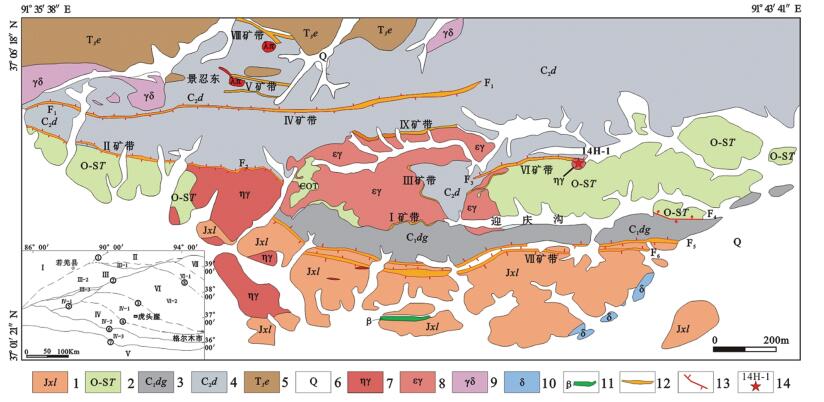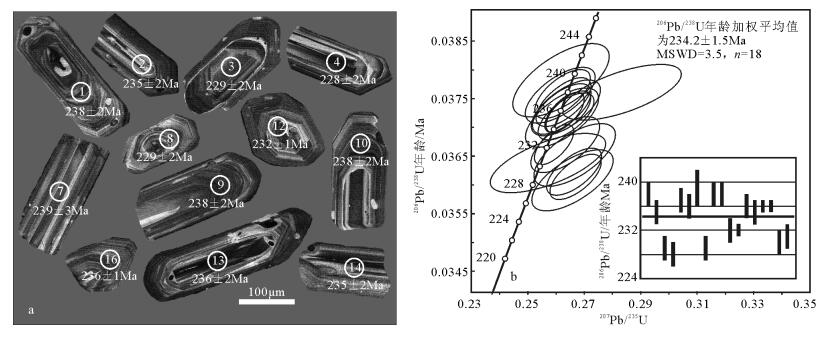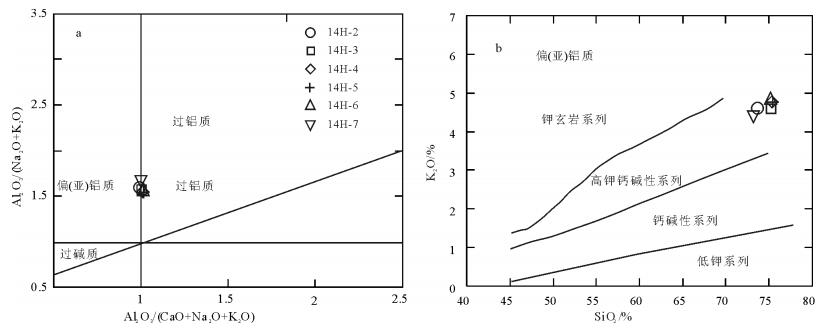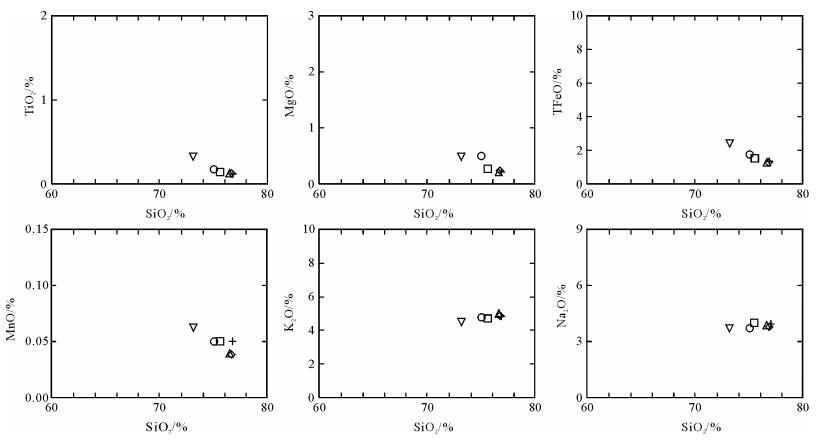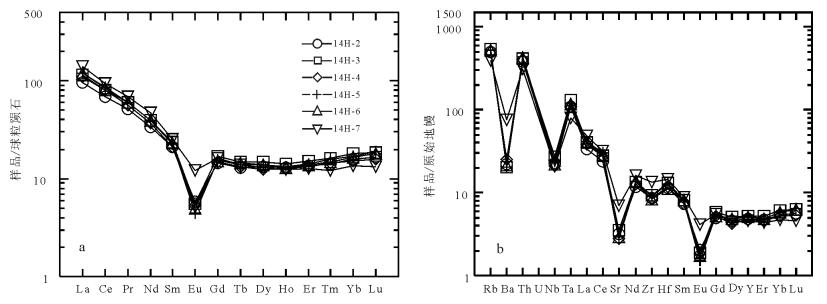A study of the ore-forming age of the Hutouya deposit and its geological significance:Geochemistry and U-Pb zircon ages of biotite monzonitic granite in Qimantag, East Kunlun Mountains
-
摘要:
虎头崖铅锌多金属矿床位于东昆仑祁漫塔格地区,矿区内中酸性侵入岩体广泛发育,且与成矿关系密切。通过高精度LA-ICP-MS锆石微区原位U-Pb同位素测年,获得与矿化、矽卡岩化关系密切的黑云二长花岗岩锆石的206Pb/238U年龄加权平均值为234.2±1.5 Ma。地球化学分析表明,黑云二长花岗岩具有高Al2O3、K2O,低TiO2、Na2O的特征,稀土和微量元素显示其富集轻稀土元素、Rb、Th和部分高场强元素,Nb、Sr、Zr相对亏损,稀土元素表现为LREE/HREE明显分离的配分模式,总体表现为I型花岗岩的特征。在(Y+Nb)-Rb图解中落入后碰撞花岗岩区,在R1-R2因子判别图上落入造山晚期和同碰撞花岗岩重叠区,显示其可能形成于碰撞-后碰撞构造阶段。虎头崖铅锌多金属矿区Ⅵ矿带具有强烈的矽卡岩化,结合矿石组构、脉石矿物、围岩蚀变等特征,认为其具有矽卡岩型矿床的特征,形成于234.2±1.5 Ma(中—晚三叠世)。
-
关键词:
- LA-ICP-MS锆石U-Pb测年 /
- 黑云二长花岗岩 /
- 构造环境 /
- 虎头崖铅锌多金属矿 /
- 矽卡岩型矿床
Abstract:The Hutouya Pb-Zn polymetallic ore deposit is located in Qimantag, East Kunlun Mountains.Intermediate-acid intru-sive rocks occur widely in this area, and are closely related to iron polymetallic mineralization.The 206Pb/238U weighted average age is 234.2±1.5 Ma, which was obtained by in-situ LA-ICP-MS zircon dating of biotite monzonitic granite that was closely related to mineralization and skarn.The results of geochemical analysis show that the biotite monzonitic granite is characterized by high Al2O3, K2O and low TiO2, Na2O.The I-type granites are characterized by rich LREE, Rb, Th and some of HFSE, but poor Nb, Sr and Zr, and clear separation of LREE from HREE.In diagram of(Y+Nb)-Rb, all samples fall into post-collision granite area, and in R1-R2 diagram, all samples fall into the superimpositon of post-collision granite area and collision granite area, indicating that the gran-ites probably formed in a collision-post-collision structural phase.The Ⅵ belt of the Hutouya Pb-Zn polymetallic ore deposit expe-riended strong skarnization.The authors hold that the deposit has characteristics of skarn deposit, as shown by its ore fabric, gangue minerals, wall rock alteration, and it was formed at 234.2±1.5 Ma (Middle-Late Triassic).
-
早中新世后,随着青藏高原隆升,亚洲季风增强,中国北方大部地区逐渐脱离原有的行星气候控制的干旱气候状况,向今天的暖温带季风气候系统转变[1-2],其生态系统也由原来的草原及荒漠草原为主的植被景观,转变为森林草原-落叶阔叶林为主[2]。亚洲季风区的典型暖温带植被系统不仅对全球周期性气候变化具有明显的指示意义,而且对过去数百万年时间的气候转型具有较好的响应,因此,是近年来研究过去全球变化的重点[3-4]。
晚新近纪以来,全球气候经历了几次重要的调整过程,其中最重要的就是中更新世时期全球气候格局的调整,又称中更新世转型[5-6]。其特征为从“高频低幅”的早更新世气候向中更新世以来“低频高幅”的气候波动,其气候变化周期由40ka的地轴倾斜度周期,转变为100ka 的轨道偏心率周期[7]。期间全球气候降温,陆地表面大部分地区因此变得更加寒冷干燥,冰期时,形成北美、欧洲的冰盖,非洲撒哈拉沙漠形成,亚洲内陆环境进一步干旱化,冬季季风强度增加等[7-9]。研究中更新世气候格局的重新调整,以及转型前后气候周期性对华北地区植被的影响,有利于了解不同区域植被对全球气候环境变化的响应特征,为研究重大气候转型中的生态环境效应提供重要对比参照物[10]。
华北平原主要包括淮北平原、黄河平原和海河平原三大区块,位于中国北方地区的东部,属典型的季风区。华北平原北部海河下游地区的凹陷盆地中沉积了厚度大于5000m 的新生带地层[11],其中第四系厚280~410m,最厚约450m。目前,基于这些新生带地层,华北地区的古植被研究已有较多积累,如河北黄骅HB1、衡水HS1 及天津CQJ1 孔花粉谱[12-14],天津G2 孔[15]。但是由于地层中花粉鉴定数量偏少、地层年代学不完善,以及区域地貌、沉积环境等多元因素的影响,用高质量孢粉数据来探讨更新世以来华北地区植被转型与气候变化问题的研究并不多见。本次研究利用华北地区东部天津滨海新区沉积凹陷中G3 钻孔的岩心材料,通过古地磁年代序列及较高质量的孢粉分析数据重建区域植被历史,并结合已有的植被重建资料,探讨第四纪以来华北地区的植被演变特征及气候变化过程。
1. 研究区自然地理概况
位于北纬32°~40°、东经114°~121°的华北平原是中国东部最主要的平原,平均海拔低于50m,由黄河、海河、淮河等带来的泥沙沉积而成。华北平原属暖温带季风气候,四季变化明显,冬季寒冷、少雪;春季干旱,夏季气温高、湿度大、降水集中;全年平均气温8~15℃。年平均降水量南部淮河区800~1000mm,黄河下游600~700mm,海河下游为500~600mm,年降水量分配不平衡,多年平均水面蒸发量为1625mm,降水随季节变化显著,冬、春季少,夏季集中[16]。
研究区自然植被主要由暖温带落叶阔叶林组成。在现代植被中,阔叶类的落叶栎(Quercus)植被组成受纬向的温度效应控制非常明显,在南部为麻栎(Quercus acutissima)、栓皮栎(Quercus variabilis),向北逐渐过渡为蒙古栎(Quercus mongolica)和辽东栎(Quercus liaotungensis)。针叶类以松属(Pinus)占主要地位,以赤松(Pinus densiflora)为主。另外常见温带的枫桦(Betula costata)、五加(Eleutherococcussenticosus)、核桃楸(Juglans mandshurica Max.)、椴属(Tilia)等。华北平原,尤其是海河平原,湖泊和沼泽广布,沼泽植被以芦苇(Phragmites)、香蒲(Ty⁃pha)、水葱(Scirpus)、苔草(Carex)等为主[17]。
全新世晚期以来,由于人类活动的持续加强,华北地区原生落叶阔叶林遭到大规模破坏,形成了今天普遍的灌丛及灌丛草原,其中灌木以荆条、酸枣为主,草丛以黄背草和白羊草为建群种。
2. 研究材料与研究方法
2.1 钻孔地理位置与磁性地层
天津G3 钻孔(孔口坐标:北纬117°25′59.5″、东经38°49′57.6″)位于华北平原东部天津滨海地区的海河南侧,构造上属于黄骅坳陷中的板桥凹陷。孔口高程2.65m,孔深905m(图 1)。岩心直径100mm,全孔取心率90.0%以上。因此,取心率和岩心状况满足磁性地层学及其他研究的要求。
G3 孔200m 以上磁性地层中共有6 个极性段,包括3 个正极性段(N1~N3)和3 个负极性段(R1~R3),正极性段分别为N1(0~85.0m)、N2(95.5~105.9m)和N3(177~191.8m),负极性段分别为R1(85.0~95.5m)、R2(105.9~177.0m)和R3(191.8~212.5m)。其中N1(0~85.0m)以正极性为主,并且包含明显的全新世海相层,对应布容极性时(Brunhes),故确定N1(0~85.0m)对应C1n(0~0.781Ma)。85.0~212.5m(R1~R3)以负极性为主,对应松山极性时(Matuyama),其中,N2(95.5~105.9m)对应C1r.1n(0.988~1.072Ma),为贾拉米罗(Jaramillo)正极性亚时,奥尔都微(Olduvai)正极性亚时持续事件长,且强度大,在渤海湾沿岸其他钻孔中亦有出现,因此推断N3(177~191.8m)对应C2n(1.778~1.945Ma),为Olduvai正极性亚时(图 2)。
2.2 花粉分析方法
天津滨海新区大港G3 钻孔花粉样品取样深度在0~905m 之间,取样间隔岩性为粘土、亚粘土、亚砂土和砂。每个样品重量为100g,经盐酸和氢氟酸处理、直径7μm 筛网筛选提取花粉化石。花粉鉴定统计在400 倍日本OLYMPUS 光学生物显微镜下进行,每个样品鉴定统计的花粉数是观察统计3 个玻片以上得到的。
在取得的165 个样品的大部分中发现了花粉化石,但仅在160m 以上发现连续而丰富的花粉,160m以下花粉数量稀少,绝大多数样品中不足50 粒。160m 以上共42 个样品中花粉相对丰富,其中绝大多数样品鉴定粒数高于100 粒,样品平均粒数为218粒。本文选择具有连续有效花粉数据的0~160m 地层(0~1.7Ma),用Tilia 软件对花粉图谱进行百分比图谱的绘制(图 3)。
2.3 研究结果
在42 个有效样品中,共鉴定了9167 粒花粉,分属48 个科属。其中针叶乔木花粉有铁杉属(Tsu⁃ga)、冷杉属(Abies)、云杉属(Picea)和松属(Pinus),落叶阔叶乔木花粉有桦属(Betula)、鹅耳枥属(Car⁃pinus)、桤木属(Alnus)、栗属(Castanea)、落叶栎属(Quercus)、椴属(Tilia)、胡桃属(Juglans)、榆属(Ul⁃mus)、糙叶树属(Aphananthe)、枫香属(Liquidanber)、山核桃属(Carya)、无患子科(Sapindaceae),灌木植物花粉有嚼床科(Acanthaceae)、胡秃子科(Elaeagna⁃ceae)、榛属(Corylus)、虎榛子属(Ostryopsis)、麻黄属(Ephedra)、忍冬科(Caprifoliaceae)、蔷薇科(Rosace⁃ae)。草本植物花粉有旱生的地榆属(Sangnisorba)、葎草属(Humulus)、藜科(Chenopodiaceae)、菊科(Compositea)、蒿属(Artemisia)、茜草科(Rubiace⁃ae)、唇形科(Labiatea)、豆科(Leguminosae)、茄科(Solanaceae)、蓼属(Polygonum)、十字花科(Crcife⁃rae)、石竹科(Caryophllaceae)、伞形花科(Umbella⁃les)等,水生植物有禾本科(Gramineae)、泽泻科(Alismataceae)、香蒲属(Typha)、莎草科(Cyperace⁃ae)、荇菜属(Nymphoides)。蕨类植物孢子有石松科(Lycopodiaceae)、水龙骨属(Polypodium)、凤尾蕨属(Pteridium)、卷柏属(Selaginella)、水蕨科(Parkeria⁃ceae)、单缝孢子(Monolites)和三缝孢子(Trilites)。
通过Canoco 4.5 软件对G3 孔中孢粉属种排序(图 4),发现所有属种可分为4 个类群:①以云杉、松为代表的温性针叶林;②以栎属、榛属、栗属、胡桃等为主的落叶阔叶林;③以蒿属、藜科、禾本科和桦属为主的草原及疏林草原;④以榆属、蔷薇科、胡颓子和铁杉为主的暖温性灌丛。根据属种的分布规律推断,图 4 中第一主轴(横轴)指示湿度,第二主轴(纵轴)指示温度。
如图 3 所示,根据孢粉聚类分析结果,将G3 孔中花粉百分比图谱分为4 个带。
(1)孢粉带Ⅰ:松属-云杉属-藜属-菊科-蕨类组合(1.6~1.2Ma)
乔木平均为58.6%,以松(12.7%~84.2%)和云杉(0~10.6%)为主,早期有少量铁杉,后过渡为云杉,此外还包含含量较低的栎属、榆属、椴属、桦属、胡桃属等常见暖温性阔叶乔木;草本中藜科最多,平均为8.1%,菊科含量平均4.3%,最高14.3%,蒿属含量少于菊科,平均仅2.8%。蕨类孢子在本带含量较丰富,以石松为主,另外还有水龙骨、凤尾蕨等蕨类。
本段组合指示暖温带针阔叶混交林的特点,其中松属为主要建群种,其花粉的突出代表性使松属在此时具有绝对优势。其中重要的变化在1.5Ma 前后,针叶林成分由铁杉向云杉转变的过程,显示一次降温事件,由此又可以划分出2 个阶段,即Ⅰ -1(1.6~1.5Ma)和Ⅰ -2(1.5~1.2Ma)。草本组合显示,1.5Ma 以前,菊科含量较高,而到后期,禾本科含量逐渐增加,菊科花粉基本消失,显示了区域草地环境由湿转干的过程。
(2)孢粉带Ⅱ:松属-栎属-藜-蒿组合(1.2~0.7Ma)
本段乔木花粉整体比例下降,松属比例由上段的平均51%下降至15%左右,云杉、铁杉等针叶树基本消失,但落叶栎属比例由带Ⅰ的1.2%,显著上升为13.0%,同时桦属花粉也显著增加,另有少量栗属、榆属、胡桃属等阔叶树。草本花粉组成也发生重要改变,藜科、蒿属比例大幅度增加,并伴随禾本科与香蒲属花粉的增加。蒿属平均值由原来的2.7%增加为20.7%。
本段孢粉组合指示暖温带落叶阔叶林的植被特征。草本花粉,尤其是蒿属的比例大幅度增加,显示华北地区在该阶段林地消退与草原发展,指示该时期气候干旱化。
(3)孢粉带Ⅲ:栎属-松属-藜-蒿-香蒲组合(0.7~0.3Ma)
本段乔木花粉比例最低,松属平均值由15%进一步下降,栎属略有下降,伴随较多的桦属与少量云杉属、铁杉属,并出现了零星的枫香属、山核桃属花粉。草本中藜科和蒿属依然占据主导地位,显示草原继续发展,而香蒲比例大幅度上升,显示周边地区湖泊湿地的扩展。本段孢粉组合指示疏林草原的植被景观,同时,湖泊湿地开始大规模发育。
(4)孢粉带Ⅳ:松属-栎属-藜-蒿-香蒲组合(0.3~0Ma)
本段针叶乔木花粉比例回升,松属增加至22.1%,云杉、铁杉花粉含量也有显著增加,而阔叶类乔木比例下降,栎属略微下降,枫香属、山核桃属消失,出现少量椴属、栗属、榆属、胡桃属等阔叶树。草本主要变化为藜科比例下降和香蒲比例升高。本段孢粉组合指示以暖温带落叶阔叶林为主的植被景观,湖泊湿地持续发育。
3. 讨论
3.1 演变趋势
中更新世气候转型期间,全球冰量整体增加了约15%,平均温度显著下降。对于其转型时间,大部分研究显示其大约开始于1.2Ma[6],另一些研究认为稍晚,在约1.05Ma,或是0.9Ma 前后,另外有人认为这种转型也可能是以一种渐进的方式进行的,始于1.2Ma,到约0.6Ma 才完成转型[18]。
G3 孔指示的中国华北平原地区中更新世植被转型期,对应上述的孢粉带Ⅱ,显示华北地区植被转型开始发生于1.2Ma,主要表现为林地减少,喜湿的针叶林比例下降,较为干旱的落叶阔叶林增加,同时藜科、蒿属、禾本科等草地面积显著增加。这种变化在1.2Ma 左右的某个时间点发生,大致相当于深海O 同位素36 阶段。
黄骅HB1、衡水HS1、天津CQJ2 孔、天津G2 孔的1.28~2.80Ma 为暖温带落叶阔叶林的景观,整体上较暖湿。1.28Ma以来,典型暖温带阔叶乔木花粉比例减小,华北平原草地扩张,而黄骅HB1 孔与衡水HS1 孔在中更新世前后也发生了类似事件[12-15]。
尽管由于孢粉数据分辨率的问题,所有这些钻孔的花粉百分比变化在时间上没有完好吻合,但是1.2Ma 前后,中更新世转型期推动华北平原地区植被整体向干旱类型发展是具有普遍性的。
此后,大约在0.7Ma 前后又发生一次重大转型,林地进一步退化,区域植被由原来的落叶阔叶林向疏林草原转变,对应深海O 同位素18 阶段。之后这种趋势一直延续到0.3Ma 左右才发生转变。黄骅HB1 孔中,0.8~0.7Ma 以后以蒿属和香蒲属为主,草本花粉出现,并分别达到12.5% 和10.9%,衡水HS1孔中以蒿和藜科为代表的草本花粉在0.78Ma 后也显著增长,显示华北平原0.7~0.8Ma 前后草地植被显著扩张[12-14]。此后,在约0.3Ma,即大约O 同位素8 阶段以后,华北地区植被中林地比例再度增加,可能与深海O 同位素11 阶段以后的7 阶段,5 阶段等几次典型的高温期有关。
3.2 周期性气候变化的区域植被响应
尽管由于样品分辨率的问题,周期性气候变化导致的区域植被变化未能完全被花粉谱记录,以致花粉谱更多地指示了区域植被在万年尺度的长期发展趋势。但是,不论是1.2Ma 之前的40ka 轨道倾斜度周期性,还是1.2Ma 之后的100ka 轨道偏心率周期,周期性气候变化对植被的影响,在花粉谱中确有一定表现。
例如在孢粉带Ⅰ中,以松为代表的乔木花粉比例的波动变化为10%~80%,可能对应该时期由地轴倾斜度40ka 周期变化导致的区域植被的变化。在带Ⅳ 也有类似的波动响应。由此可见,不论是1.2Ma 之前40ka 周期的“ 高频低幅”变化,还是1.2Ma 之后,100ka 周期的“低频高幅”变化,对华北地区的植被都有显著影响。
如图 3 所示,华北地区植被在1.6~1.2Ma 期间在40ka 气候周期“高频低幅”的变化中,主要表现为松属、常绿栎、铁杉属、胡桃属的交替变化,指示了区域暖温性与温性植被林地类型的交替变化。而1.2Ma 之后随着草原植被的扩张,100ka 周期的“低频高幅”变化造成的华北地区区域植被的响应更多地表现为草原与森林的交替发展。
4. 结论
华北平原东北部天津G3 孔孢粉数据及周边地区已有花粉研究表明,华北平原地区1.6Ma 以来的植被演化主要可以分为4 个阶段:①1.6~1.2Ma 密闭度较高的暖温带针阔叶混交林;②1.2~0.7Ma 开阔的暖温带落叶阔叶林;③0.7~0.3Ma,阔叶疏林草原;④0.3Ma 至今,暖温带落叶阔叶林。
中国华北平原地区中更新世植被转型期对应于孢粉带Ⅱ,显示该转型始于1.2Ma,大致对应深海O 同位素36 阶段。主要特征为林地减少、喜湿的针叶林比例下降,较为干旱的落叶阔叶林增加,同时,藜科、蒿属、禾本科等草地面积显著增加。
大约在0.7Ma 前后又发生一次重大转型,林地进一步退化,区域植被由原来的落叶阔叶林向疏林草原转变,对应深海O 同位素18 阶段。
G3 孔代表的花粉谱显示,1.6Ma 以来气候周期性的变化对华北地区区域植被有较显著的影响。
在1.2Ma 之前,受40ka 轨道倾斜度气候周期性的影响,主要表现为植被林地类型的交替发展;在1.2Ma之后,受100ka 轨道偏心率气候周期性影响,主要表现为草原与森林交替发展。
致谢: 在论文完成过程中,中国地质调查局西安地质调查中心计文化研究员、陈守建教授级高工给予了大力的支持和鼓励;镜下鉴定过程中得到中国地质调查局西安地质调查中心叶芳研究员、张汉文研究员的帮助;数据测试过程中得到西北大学柳小明教授的有益帮助,在此一并表示衷心的谢意。 -
图 1 虎头崖铅锌多金属矿区地质简图(据参考文献[11]修改)
1—蓟县系狼牙山组;2—奥陶系-志留系滩间山群;3—下石炭统大干沟组;4—上石炭统缔敖苏组;5—上三叠统鄂拉山组;6—第四系;7—二长花岗岩;8—钾长花岗岩;9—花岗闪长岩;10—闪长岩;11——辉绿岩脉;12—矽卡岩化带;13—断层;14—采样位置及编号;Ⅰ—塔里木陆块;Ⅱ—阿北-敦煌地块;Ⅲ—阿尔金造山带;Ⅲ-1—红柳沟-拉配泉蛇绿构造混杂岩带;Ⅲ-2—阿中地块;Ⅲ-3—阿帕-茫崖早古生代蛇绿构造混杂岩带;Ⅳ—昆仑造山带;Ⅳ-1—北昆仑(祁漫塔格)岩浆弧带;Ⅳ-2—中昆仑微地块;Ⅳ-3—昆南增生楔杂岩带;Ⅴ—巴颜喀拉褶皱带;Ⅵ—柴达木陆块;Ⅵ-1—柴达木盆地北缘;Ⅵ-2—柴达木盆地;Ⅶ—祁连造山带;①—阿尔金北缘断裂;②—阿尔金南缘断裂;③—昆北断裂带;④—黑山-那陵格勒断裂;⑤—白干湖断裂;⑥—昆中断裂带;⑦—昆南断裂带;⑧—柴北缘断裂
Figure 1. Geological sketch map of the Hutouya Pb-Zn polymetallic ore deposit
图 5 虎头崖铅锌多金属矿黑云二长花岗岩的Harker图解(图例同图 4)
Figure 5. Harker diagram of biotite monzonitic granite in the Hutouya Pb-Zn polymetallic ore deposit
图 6 黑云二长花岗岩稀土元素球粒陨标准化配分图解(a)和微量元素原始地幔标准化蛛网图(b)[22]
Figure 6. Chondrite-normalized REE patterns(a) and primitive-mantle normalised spidergram (b)for biotite monzonitic granite
表 2 黑云二长花岗岩主量元素含量
Table 2 Major element composition of biotite monzonitic granite
% 样品编号 SiO2 TiO2 Al2O3 Fe2O3 FeO MnO MgO CaO 14H-2 74.88 0.17 12.96 0.49 1.38 0.05 0.53 1.38 14H-3 75.40 0.12 13.15 0.58 1.05 0.05 0.23 1.04 14H-4 76.35 0.11 12.75 0.36 0.97 0.04 0.20 0.93 14H-5 76.36 0.11 12.69 0.55 0.82 0.05 0.17 0.92 14H-6 76.33 0.10 12.83 0.34 0.97 0.04 0.15 0.91 14H-7 73.26 0.25 13.85 0.36 1.85 0.06 0.51 1.80 样品编号 Na2O K2O P2O5 TFeO 里特曼指数 TFeO/MgO AR A/CNK 14H-2 3.40 4.70 0.05 1.82 2.06 3.45 3.60 0.98 14H-3 3.67 4.66 0.05 1.57 2.14 6.75 3.84 1.01 14H-4 3.44 4.80 0.04 1.30 2.04 6.42 4.03 1.02 14H-5 3.50 4.79 0.04 1.32 2.06 7.68 4.11 1.01 14H-6 3.47 4.82 0.04 1.28 2.06 8.44 4.04 1.02 14H-7 3.46 4.50 0.09 2.18 2.10 4.31 3.07 1.00 表 1 虎头崖铜多金属矿区黑云二长花岗岩(14H-1) LA-ICP-MS单颗粒锆石U-Th-Pb同位素测年结果
Table 1 LA-ICP-MS zircon U-Th-Pb isotopic dating of biotite monzonitic granite (14H-1) of the copper polymetallic ore district in Hutouya area
测点编号 同位素含量/10-6 同位素比值 年龄/Ma Th/U 谐和度 Th U Pb* 207Pb/206Pb 207Pb/235U 206Pb/238U 208Pb/232Th 207Pb/206Pb 207Pb/235U 206Pb/238U 208Pb/232Th 比值 1σ 比值 1σ 比值 1σ 比值 1σ 年龄 1σ 年龄 1σ 年龄 1σ 年龄 1σ 1 161 439 18 0.0546 0.0027 0.283 0.014 0.0376 0.0003 0.0117 0.0002 397 115 253 11 238 2 236 3 0.37 106.30 2 195 452 18 0.0514 0.0014 0.264 0.007 0.0372 0.0003 0.0120 0.0002 258 44 238 5 235 2 241 4 0.43 101.28 3 254 504 21 0.0533 0.0014 0.266 0.006 0.0362 0.0003 0.0120 0.0002 342 41 240 5 229 2 241 3 0.50 104.80 4 208 314 14 0.0534 0.0020 0.266 0.010 0.0361 0.0004 0.0121 0.0002 347 63 239 8 228 2 244 4 0.66 104.82 5 193 489 20 0.0509 0.0014 0.263 0.006 0.0374 0.0003 0.0122 0.0002 235 43 237 5 237 2 246 4 0.39 100.00 6 140 278 11 0.0512 0.0017 0.263 0.008 0.0373 0.0003 0.0111 0.0002 248 55 237 6 236 2 223 4 0.50 100.42 7 405 786 33 0.0502 0.0023 0.262 0.011 0.0378 0.0004 0.0125 0.0003 204 79 236 9 239 3 250 6 0.52 98.74 8 254 472 20 0.0536 0.0013 0.267 0.006 0.0361 0.0003 0.0114 0.0001 353 38 240 5 229 2 230 3 0.54 104.80 9 168 384 16 0.0505 0.0017 0.261 0.008 0.0376 0.0003 0.0120 0.0002 218 57 236 7 238 2 240 5 0.44 99.16 10 280 496 21 0.0506 0.0014 0.262 0.006 0.0376 0.0003 0.0126 0.0002 224 43 237 5 238 2 252 3 0.56 99.58 11 238 476 21 0.0520 0.0017 0.263 0.008 0.0367 0.0003 0.0130 0.0002 286 54 237 6 232 2 262 4 0.50 102.16 12 208 382 16 0.0513 0.0010 0.259 0.005 0.0367 0.0002 0.0115 0.0001 252 29 234 4 232 1 231 2 0.54 100.86 13 217 352 15 0.0509 0.0014 0.262 0.007 0.0373 0.0003 0.0123 0.0002 237 46 236 6 236 2 247 3 0.62 100.00 14 166 366 15 0.0512 0.0018 0.262 0.009 0.0372 0.0003 0.0121 0.0002 248 58 236 7 235 2 243 5 0.45 100.43 15 309 748 30 0.0512 0.0010 0.263 0.005 0.0373 0.0002 0.0124 0.0001 250 29 237 4 236 1 249 3 0.41 100.42 16 210 423 18 0.0514 0.0011 0.264 0.005 0.0373 0.0002 0.0123 0.0001 261 33 238 4 236 1 247 3 0.50 100.85 17 224 354 17 0.0513 0.0027 0.257 0.014 0.0364 0.0003 0.0115 0.0001 253 125 232 11 230 2 230 2 0.63 100.87 18 447 1015 43 0.0530 0.0020 0.267 0.010 0.0365 0.0004 0.0129 0.0003 327 63 240 8 231 2 259 6 0.44 103.90 注:Pb*=0.241* 206Pb+0.221* 207Pb+0.524* 208Pb 表 3 黑云二长花岗岩稀土和微量元素含量
Table 3 REE and trace elements composition of biotite monzonitic granite
10-6 样品编号 10H-2 10H-3 10H-4 10H-5 10H-6 10H-7 La 22.80 27.50 26.20 28.30 28.20 33.30 Ce 42.10 49.10 48.80 53.20 51.10 57.30 Pr 4.88 5.75 5.36 5.77 5.78 6.61 Nd 15.90 18.40 17.20 18.60 18.60 22.10 Sm 3.25 3.62 3.26 3.48 3.58 3.88 Eu 0.34 0.32 0.31 0.26 0.29 0.70 Gd 2.97 3.50 3.08 3.22 3.14 3.31 Tb 0.49 0.56 0.50 0.52 0.54 0.52 Dy 3.35 3.75 3.14 3.53 3.54 3.27 Ho 0.74 0.81 0.72 0.75 0.74 0.71 Er 2.25 2.50 2.22 2.34 2.31 2.10 Tm 0.36 0.41 0.37 0.40 0.38 0.31 Yb 2.67 3.05 2.58 2.90 2.83 2.33 Lu 0.42 0.47 0.40 0.48 0.46 0.34 ΣREE 102.52 119.74 114.14 123.75 121.49 136.78 LREE 89.27 104.69 101.13 109.61 107.55 123.89 HREE 13.25 15.05 13.01 14.14 13.94 12.89 LREE/HREE 6.74 6.96 7.77 7.75 7.72 9.61 (La/Yb)N 5.76 6.08 6.85 6.58 6.72 9.64 δEu 0.33 0.27 0.29 0.23 0.26 0.58 Ba 156.00 142.00 176.00 143.00 152.00 529.00 Rb 316.00 343.00 314.00 330.00 329.00 249.00 Sr 67.40 75.30 59.60 61.50 62.40 146.00 Co 3.14 1.57 1.18 1.06 0.94 3.10 V 13.30 6.23 4.64 4.42 3.75 14.20 Cr 2.61 2.00 1.56 1.88 3.28 1.43 Ni 2.34 0.93 1.74 0.44 1.50 0.77 Nb 16.10 19.30 14.80 17.10 15.90 14.80 Ta 4.52 5.41 4.44 4.90 4.85 3.27 Zr 96.00 105.00 95.20 102.00 94.80 151.00 Hf 3.51 4.06 3.66 3.96 3.47 4.49 Y 22.00 24.10 21.40 23.90 23.10 20.80 Th 32.90 35.70 34.50 37.30 36.50 26.50 Sc 2.28 1.40 1.30 1.19 1.19 2.76 Rb/Ba 2.03 2.42 1.78 2.31 2.16 0.47 Nb/Ta 3.56 3.57 3.33 3.49 3.28 4.53 -
李荣社, 计文化, 潘晓萍, 等. 1:100万昆仑山及邻区地质图及说明书[M].北京:地质出版社, 2009. 张爱奎, 莫宣学, 李云平, 等.青海西部祁漫塔格成矿带找矿新进展及其意义[J].地质通报, 2010, 29(7):1062-1074. http://dzhtb.cgs.cn/ch/reader/view_abstract.aspx?flag=1&file_no=20100713&journal_id=gbc 刘云华, 莫宣学, 张雪亭, 等.东昆仑野马泉地区矽卡岩矿床地质特征及控矿条件[J].华南地质与矿产, 2005, (3):18-23. http://www.cnki.com.cn/Article/CJFDTOTAL-HNKC200503003.htm 张爱奎, 李云平, 刘光莲, 等.虎头崖铜铅锌矿床类型新认识及其意义[J].青海国土经略, 2008, (4):25-27. http://www.cnki.com.cn/Article/CJFDTOTAL-GTJL200804013.htm 胡杏花, 朱谷昌, 刘欢, 等.祁漫塔格矿带虎头崖多金属矿矿床特征和成矿作用分析[J].地质与勘探, 2011, 47(2):216-221. http://www.cnki.com.cn/Article/CJFDTOTAL-DZKT201102012.htm 古凤宝, 吴向农, 姜常义.东昆仑华力西期-印支期花岗岩组合及构造环境[J].青海地质, 1996, 5(1):18-26. http://www.cnki.com.cn/Article/CJFDTOTAL-GTJL199601001.htm 袁万明, 莫宣学, 喻学惠, 等.东昆仑印支期区域构造背景的花岗岩记录[J].地质论评, 2000, 46(2):203-221. http://www.cnki.com.cn/Article/CJFDTOTAL-DZLP200002012.htm 李光明, 沈远超.东昆仑祁漫塔格地区华力西期花岗岩地质地球化学特征[J].地质与勘探, 2001, (1):73-78. http://www.cnki.com.cn/Article/CJFDTOTAL-DZKT200101016.htm 罗照华, 柯珊, 曹永清, 等.东昆仑印支晚期幔源岩浆活动[J].地质通报, 2002, 21(6):292-297. http://dzhtb.cgs.cn/ch/reader/view_abstract.aspx?flag=1&file_no=20020677&journal_id=gbc 王松, 丰成友, 李世金, 等.青海祁曼塔格卡尔却卡铜多金属矿区花岗闪长岩锆石SHRIMP U-Pb测年及其地质意义[J].中国地质, 2009, 36(1):74-84. http://www.cnki.com.cn/Article/CJFDTOTAL-DIZI200901008.htm 李侃, 高永宝, 钱兵, 等.东昆仑祁漫塔格虎头崖铅锌多金属矿区花岗岩年代学、地球化学及Hf同位素特征[J].中国地质, 2015, 42(3):630-645. http://www.cnki.com.cn/Article/CJFDTOTAL-DIZI201503017.htm Gao S, Liu X M, Yuan H L, et al. Analysis of forty-two major and trace elements of USGS and NIST SRM Glasses by LA-ICPMS[J]. Geostand Newsl., 2002, 22:181-195. https://www.researchgate.net/publication/252188504_Analysis_of_forty-two_major_and_trace_elements_in_USGS_and_NIST_SRM_glasses_by_LA-ICPMS
刘小明, 高山, 袁洪林, 等. 193nm LA-ICPMS对国际地质标准参考物中42种主元素和微量元素的分析[J].岩石学报, 2002, 18(3):408-418. http://kns.cnki.net/KCMS/detail/detail.aspx?filename=ysxb200203016&dbname=CJFD&dbcode=CJFQ 袁洪林, 吴福元, 高山, 等.东北地区新生代侵入体的锆石激光探针U-Pb年龄测定与稀土元素成分分析[J].科学通报, 2003, 48(14):1511-1520. doi: 10.3321/j.issn:0023-074X.2003.14.008 Anderson T. Correction of common lead in U-Pb analyses that do not report 204 Pb[J]. Chemical Geology, 2002, 192:59-79. doi: 10.1016/S0009-2541(02)00195-X
Ludwig K R. 3.0-A geochronology cal toolkit for Micro-soft Excel[J]. Berkeley Geochronology Center, Special Publication, 2003, (4):1-70.
Hoskin P W O, Black L P. Metamorphic zircon formation by solid-state recrystallization of protolith igneous zircon[J]. Journal of Metamorphic Geology, 2000, 18:423-439. https://www.researchgate.net/publication/229968849_Metamorphic_zircon_formation_by_solid-state_recrystallization_of_protolith_igneous_zircon
Turner S P, Foden J D, Morrison R S. Derivation of some A-type magmas by fractionation of basaltic agama:an example from the Padthaway Ridge, South Australia[J]. Lithos, 1992, 28:151-179. doi: 10.1016/0024-4937(92)90029-X
Chappell B W, White A J R. Two contrasting granite types[J]. Pacific Geology, 1974, 8:173-174. http://geoscienceworld.org/georef/1975-030452
Maniar P D, Piccoli P M. Tectonic discrimination of granitoids[J]. GSA Bull., 1989, 101(5):635-643. doi: 10.1130/0016-7606(1989)101<0635:TDOG>2.3.CO;2
Richwood P C. Boundary lines within petrologic diagrams which use oxides of major and minor elements[J]. Lithos, 1989, 22(4):247-263. doi: 10.1016/0024-4937(89)90028-5
Sun S S, Mc Donoungh W F. Chemical and isotopic systematics of oceanic basalt:implication for mantle composition and processes[C]//Saunders A D, Norry M J. Magmatism in the Ocean Basins. Geol. Soc. London Spec. Pub., 1989, 42:313-345.
Pearce J A. Sources and setting of granitic rocks[J]. Episodes, 1996, 19(4):120-125. https://www.researchgate.net/publication/262099137_Sources_and_Settings_of_Granitic_Rocks
Harris N B W, Pearce J A, Tindle A G. Geochemical characteristics of collision-zone magmatism[J]. Geological Society of London, Special Publication, 1986, 19:67-81. doi: 10.1144/GSL.SP.1986.019.01.04
Williamson B J, Shaw A, Downes H, et al. Geochemical constraints on the genesis of Hercynian two-micaleucogranites from the Massive Central[J]. Chemical Geology, 1996, 127:25-42. doi: 10.1016/0009-2541(95)00105-0
Pitcher W S. Granite type and tectonic environment[M]. Mountain Building Processes, London:Academic Press, 1983:19-40.
Forster H J, Tischendorf G, Gottesmann B, et al. Late-collisional granites in the Variscan Erzgebirge[J]. Journal of Petrology, 1999, 40:1613-1645. doi: 10.1093/petroj/40.11.1613
Kalsbeek F, J epsen H, Nutman A. From source migmatitesto to plutons:tracking the origin of ca. 435 Ma S-type granites in the East Greenland Caledonian orogen[J]. Lithos, 2001, 57:1-21. doi: 10.1016/S0024-4937(00)00071-2
肖庆辉, 邓晋福, 马大诠, 等.花岗岩研究思维与方法[M].北京:地质出版社, 2002. Liegeois G P, Navez J, Hertongen J, et al. Contrasting origin of post-collisional high-K calc-alkaline and shoshonitic versus alkaline and peralkaline granitoids:the use of sliding normalization[J]. Lithos, 1998, 45:1-28. doi: 10.1016/S0024-4937(98)00023-1
韩宝福.后碰撞花岗岩类的多样性及其构造环境判别的复杂性[J].地学前缘, 2007, 14(3):64-72. http://www.cnki.com.cn/Article/CJFDTOTAL-DXQY200703007.htm 任继舜, 姜春发, 张正坤, 等.中国大地构造及其演化[M].北京:科学出版社, 1980:1-124. 殷鸿福, 张克信.中央造山带的演化及其特点[J].地球科学, 1998, 23(5):437-442. http://www.cnki.com.cn/Article/CJFDTOTAL-DQKX805.000.htm 袁万明, 莫宣学, 喻学惠, 等.东昆仑印支期区域构造背景的花岗岩记录[J].地质论评, 2000, 46(2):203-211. http://www.cnki.com.cn/Article/CJFDTOTAL-DZLP200002012.htm 莫宣学, 罗照华, 邓晋福, 等.东昆仑造山带花岗岩及地壳生长[J].高校地质学报, 2007, 13(3):403-414. http://www.cnki.com.cn/Article/CJFDTOTAL-GXDX200703005.htm 校培喜, 高晓峰, 胡云绪, 等.阿尔金-东昆仑西段成矿带地质背景研究[M].北京:地质出版社, 2014:1-261. 罗照华, 邓晋福, 曹永清, 等.青海省东昆仑地区晚古生代-早中生代火山活动与区域构造演化[J].现代地质, 1999, 13(1):51-56. http://www.cnki.com.cn/Article/CJFDTOTAL-XDDZ901.007.htm Pearce J A, Harris N B W, Tindle A G. Trace element discrimination diagrams for the tectonic interpretation of granitic rocks[J]. Petrol, 1984, 25(4):956-983. doi: 10.1093/petrology/25.4.956
Batchelor R A, Bowden P. Petrogentic interpretation of granitoid rocks series using multicationic[J]. Chemical Geology, 1985, 48:43-45. doi: 10.1016/0009-2541(85)90034-8
Zhao X X, Coe R S, Gilder S A, et al. Palaeomagnetic constraints on the palaeogeography of China:implications for Gondwanaland[J]. Australian Journal of Earth Sciences, 1996, 43(6):643-672. doi: 10.1080/08120099608728285
Liegeois J P, Navez J, Hertogen J, et al. Contrasting origin of postcollisional high-K calc-alkaline and shoshonitic versus alkaline and per alkaline granitoids[J]. Lithos, 1998, 45(1):1-28. https://www.researchgate.net/publication/222483323_Contrasting_origin_of_post-collisional_high-K_calc-alkaline_and_shoshonitic_versus_alkaline_and_peralkaline_granitoids_The_use_of_sliding_normalization
刘成东, 张文秦, 莫宣学, 等.东昆仑约格鲁岩体暗色微粒包体特征及成因[J].地质通报, 2002, 21(11):739-744. doi: 10.3969/j.issn.1671-2552.2002.11.009 佘宏全, 张德全, 景向阳, 等.青海省乌兰乌珠尔斑岩铜矿床地质特征与成因[J].中国地质, 2007, 34(2):306-314. http://www.cnki.com.cn/Article/CJFDTOTAL-DIZI200702013.htm 李世金, 孙丰月, 丰成友, 等.青海东昆仑鸭子沟多金属矿的成矿年代学研究[J].地质学报, 2008, 82(7):949-955. http://www.cnki.com.cn/Article/CJFDTOTAL-DZXE200807015.htm 吴祥珂, 孟繁聪, 许虹, 等.青海祁漫塔格玛兴大坂晚三叠世花岗岩年代学、地球化学及Nd-Hf同位素组成[J].岩石学报, 2011, 27(11):3380-3394. http://www.cnki.com.cn/Article/CJFDTOTAL-YSXB201111018.htm 高永宝, 李文渊, 马晓光, 等.东昆仑尕林格铁矿床成因年代学及Hf同位素制约[J].兰州大学学报(自然科学版), 2012, 48(2):36-47. http://www.cnki.com.cn/Article/CJFDTOTAL-LDZK201202008.htm 高永宝, 李文渊, 钱兵, 等.东昆仑野马泉铁矿相关花岗质岩体年代学、地球化学及Hf同位素特征[J].岩石学报, 2014, 30(6):1647-1665. http://www.cnki.com.cn/Article/CJFDTOTAL-YSXB201406009.htm 丰成友, 王松, 李国臣, 等.青海祁漫塔格中晚三叠世花岗岩:年代学、地球化学及成因意义[J].岩石学报, 2012, 28(2):665-678. http://www.cnki.com.cn/Article/CJFDTOTAL-YSXB201202025.htm 高永宝, 李文渊, 李侃, 等.青海祁漫塔格虎头崖铅锌矿床流体包裹体、同位素地球化学及矿床成因[J].地质通报, 2013, 32(10):1631-1642. doi: 10.3969/j.issn.1671-2552.2013.10.015 马圣钞, 丰成友, 李国臣, 等.青海虎头崖铜铅锌多金属矿床硫、铅同位素组成及成因意义[J].地质与勘探, 2012, 48(2):321-331. http://www.cnki.com.cn/Article/CJFDTOTAL-DZKT201202015.htm




 下载:
下载:



